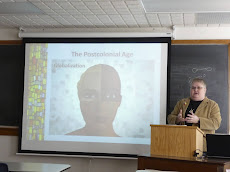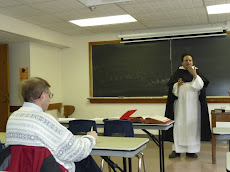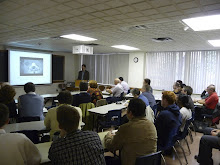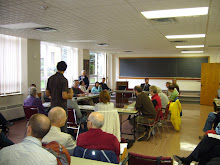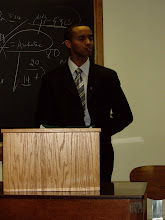skip to main |
skip to sidebar
Praying with the Angels at Qumran
by Prof. Judith H. Newman A.B (Princeton University), M.A.R. (Harvard University) (Emmanuel College)
 Of the many liturgical texts found among the Dead Sea Scrolls, the Songs of the Sabbath Sacrifice are perhaps the most intriguing and mystifying. Indeed, some scholars have pointed to the collection as representing one of the roots of Jewish mysticism. It will be argued that this series of thirteen liturgical pieces that were offered during the first thirteen sabbaths of the solar year in fact offered a transformative rite in which the participants might be transformed into a (near) angelic state. The Songs’ allusive use of Isaiah 6 and Ezekiel 1 make them a not-so-distant relative of the Christian Sanctus and Jewish Qedushah.”
Of the many liturgical texts found among the Dead Sea Scrolls, the Songs of the Sabbath Sacrifice are perhaps the most intriguing and mystifying. Indeed, some scholars have pointed to the collection as representing one of the roots of Jewish mysticism. It will be argued that this series of thirteen liturgical pieces that were offered during the first thirteen sabbaths of the solar year in fact offered a transformative rite in which the participants might be transformed into a (near) angelic state. The Songs’ allusive use of Isaiah 6 and Ezekiel 1 make them a not-so-distant relative of the Christian Sanctus and Jewish Qedushah.”
Prof. Judith H. Newman of Emmanuel College, will be presenting “Praying with the Angels at Qumran.” Prof. Newman is Associate Professor of Religion and Old Testament/Hebrew Bible at Emmanuel College, and cross-appointed to the Department and Centre for the Study of Religion and the Department of Near and Middle Eastern Civilizations at the University of Toronto. She is the author of Praying by the Book: The Scripturalization of Prayer in Second Temple Judaism, co-author of Early Jewish Liturgy and Early Jewish Prayers in Greek, as well as the fifth edition of the contemporary classic, with Bernhard Anderson and Steven Bishop, Understanding the Old Testament. She is currently at work on a monograph, The Liturgical Imagination about the intersection of scripture, ritual performance, and prayer in early Judaism and Christianity.
Space as Worship
by Gerald Robinson B.Sc., (Engineering) Ph.D.(Leeds) M.Arch. (Harvard) (Trinity College)
 This seminar will establish a union between space and worship in a realm where Architecture meets Theology. We will discover a liturgy where space will pray with us, and our worship will gather us up. For these entities to participate in such a meeting each must be configured so it will be compatible with the other - space must have a language that can convey meaning, and worship must have a structural logic. The value of this union is that it enables us to create and order spaces that will support our ministries. Gerald Robinson, a Liturgical Consultant, has assisted many churches in creating supportive worship space. He teaches an M.Div. course "Shaping Space for Worship" for T.S.T. at Trinity College.
This seminar will establish a union between space and worship in a realm where Architecture meets Theology. We will discover a liturgy where space will pray with us, and our worship will gather us up. For these entities to participate in such a meeting each must be configured so it will be compatible with the other - space must have a language that can convey meaning, and worship must have a structural logic. The value of this union is that it enables us to create and order spaces that will support our ministries. Gerald Robinson, a Liturgical Consultant, has assisted many churches in creating supportive worship space. He teaches an M.Div. course "Shaping Space for Worship" for T.S.T. at Trinity College.
Congregational Song as Liturgical Theology
by Rev. Nancy E. Hardy, Mus. Bac., ARCT, M.R.E., MDiv, ThD. cand. (Emmanuel College)
 We learn about God in our spoken words of prayer and praise. We also learn about God through the hymns we sing, for our congregational songs can articulate our theology—what we believe about God in Christ and the work of the Holy Spirit in the world. Drawing on the church’s congregational songs, Nancy Hardy will invite us to discover liturgical theology within the hymns we sing. The Rev. Hardy has had a varied pastoral and educational ministry within The United Church of Canada, working in congregations in the Maritimes and southern Ontario and serving as Mission Study Editor at the United Church’s national office. She has written and edited numerous publications within the United Church, including “Gathering,” a major liturgical resource. She co-chaired the committee responsible for the publication of Voices United, the hymnbook of The United Church of Canada.
We learn about God in our spoken words of prayer and praise. We also learn about God through the hymns we sing, for our congregational songs can articulate our theology—what we believe about God in Christ and the work of the Holy Spirit in the world. Drawing on the church’s congregational songs, Nancy Hardy will invite us to discover liturgical theology within the hymns we sing. The Rev. Hardy has had a varied pastoral and educational ministry within The United Church of Canada, working in congregations in the Maritimes and southern Ontario and serving as Mission Study Editor at the United Church’s national office. She has written and edited numerous publications within the United Church, including “Gathering,” a major liturgical resource. She co-chaired the committee responsible for the publication of Voices United, the hymnbook of The United Church of Canada.
 Of the many liturgical texts found among the Dead Sea Scrolls, the Songs of the Sabbath Sacrifice are perhaps the most intriguing and mystifying. Indeed, some scholars have pointed to the collection as representing one of the roots of Jewish mysticism. It will be argued that this series of thirteen liturgical pieces that were offered during the first thirteen sabbaths of the solar year in fact offered a transformative rite in which the participants might be transformed into a (near) angelic state. The Songs’ allusive use of Isaiah 6 and Ezekiel 1 make them a not-so-distant relative of the Christian Sanctus and Jewish Qedushah.”
Of the many liturgical texts found among the Dead Sea Scrolls, the Songs of the Sabbath Sacrifice are perhaps the most intriguing and mystifying. Indeed, some scholars have pointed to the collection as representing one of the roots of Jewish mysticism. It will be argued that this series of thirteen liturgical pieces that were offered during the first thirteen sabbaths of the solar year in fact offered a transformative rite in which the participants might be transformed into a (near) angelic state. The Songs’ allusive use of Isaiah 6 and Ezekiel 1 make them a not-so-distant relative of the Christian Sanctus and Jewish Qedushah.”

